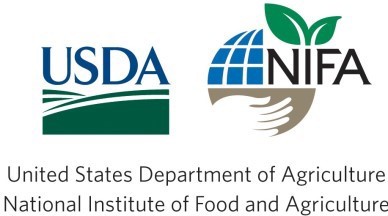By Victoria Wallace and Alyssa Siegel-Miles, UConn Extension
Overview
Moles are usually of little concern in managed landscapes. They are typically only noticed when their activity causes damage to turf grasses or landscape plants. High mole populations may generate greater concern, particularly on school properties that must be managed as pesticide-free. Damage from mole activity is most prevalent in the early spring, after snow melt and prior to the upcoming spring sports season, when grounds managers are typically assessing the overall health of their athletic fields and school landscapes.
Identification
The eastern or common mole, Scalopus aquaticus (Figure 1), is a small mammal, slightly larger than a mouse. Moles have short, gray fur; a long, pointed snout; a short tail; and pink nose and feet. The palms of their distinct, wide, clawed forefeet face outwards, making them uniquely well-suited for digging. Moles live almost entirely underground. As vision is unnecessary in such dark conditions, their eyes are sealed shut and usually hidden under fur.
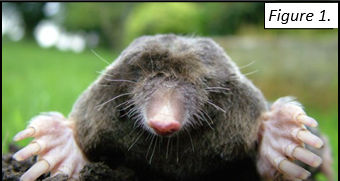
Behavior and Biology
Moles play an important role in the ecosystem food chain, serving as both predators and prey. They are a common staple in the diets of hawks, owls, and snakes. Moles are insectivores that feed on invertebrates, primarily earthworms and insects (including grubs). They rarely consume plant roots or bulbs. Moles can enhance soil health; their digging activity aerates the soil and allows air and water to move more deeply into the soil profile.
Moles mate in February-March; a litter of 3-4 young is typically borne in March-May. Adult moles prefer a solitary existence and usually only co-exist with other moles during the breeding season. Moles are active year-round, although activity near the soil surface slows during extreme heat, cold, or drought. They are most active in the landscape in spring and fall, particularly after rain, when the ground is soft and digging new tunnels is easiest.
Trails of rounded mounds or small holes at the surface of the soil are indicators of mole activity in the landscape. Mounds are formed as moles move and push up soil during the formation of underground tunnels or runways. The resulting network of tunnels and runways can be quite extensive. Moles have been observed to tunnel aggressively and quickly, sometimes even excavating soil in small chunks.
In addition to runway tunnels, which are used for navigating to new locations in search of food, moles also dig deeper passages, 8-12 inches beneath the surface, which are used primarily to raise their young. The tunnels and burrows may be used by several generations of moles. Occasionally, other burrowing animals, such as shrews or voles, may also use mole tunnels.
It may be difficult to determine how many moles are living within an active burrow system. Generally, one acre of land will support two to three moles at a time (Pierce, 2015). Properties with exceptionally healthy soils (i.e., with abundant organic matter and where food sources are prevalent, such as those near large, forested areas or former pastures), may support many moles.
Damage to Landscape Plants and Turf grass
Mole damage in landscape beds or turf grass areas is the result of tunneling in search of worms, insects, and other invertebrates (Figure 2). Mounds and ridges are formed when the moles burrow at the interface between the soil surface and the turfgrass or landscape plants. The ground can become dangerously bumpy and uneven, particularly if many moles are active in one area. The uneven surface attributed to mounding may cause an aesthetic problem in landscape planting beds. Plants with roots that are dislodged and separated from the soil can dry out, sustaining injury or death.
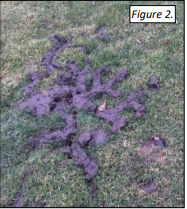
Consistent mowing is an extremely important cultural practice to maintain safe playing fields, as mowing keeps turf density uniform and weed populations in check. Aggressive tunneling by moles and the resultant mounding can make mowing difficult and increase mowing damage, especially scalping of raised turfgrass. Equipment wheels can lodge in the burrows, causing ruts, which will either contribute to an uneven playing surface or create pockets of open soil that are prone to weed invasion. When soils dry, tunnels on non-irrigated fields are kicked by students, exposing soil that must be over seeded to ensure player safety and reduce weed populations.
When mole activity impacts the health of landscape plants, makes lawn maintenance practices difficult, or impacts player safety, their presence in the municipal or school landscape may not be tolerable.

Mole Damage Prevention and Repair
Moles seek locations that provide them with an abundant food supply. Turf grass areas or landscape plantings that are regularly irrigated and have a high amount of organic matter, particularly those that are maintained with an organic management program, often have larger populations of the invertebrates (i.e., microflora, insects, earthworms) which attract moles to feed.
If soil tests indicate that the organic matter content of the soil is adequate, limit applications of compost, especially where there has been a history of mole activity. Use of compost on school grounds must always comply with regulations, as described in the CT Phosphorus law.
Repair of Landscaped Areas
Repeatedly tamp down tunnels that have displaced plants in the landscape to ensure that plant roots remain in contact with soil. Irrigate those plants to encourage rooting. If plants continue to be dislodged in high visibility locations, the use of barriers around key specimen plants may be warranted.
Repair of Turfgrass Areas
If mole activity or new tunnels are observed in the spring, roll or tamp down uneven areas of the lawn or athletic fields to ensure that turf grass roots are in contact with the soil, enabling the turf grass to re-root and recover from the damage. Irrigation to enhance recovery is recommended.
If turf grass has died or there are open areas of soil, the affected areas must be renovated and over seeded.
Once re-seeded, fertilize and irrigate affected areas to encourage turf growth and recovery.
Management and Control
School grounds managers face a significant challenge to reduce mole populations above tolerable thresholds on pesticide-free school properties. Scouting is critical, as control efforts should begin as soon as active holes, mounds, or surface runways are evident, to keep damage to a minimum. Without the use of chemical control options, a combination of techniques may be required.
Traps or other control devices may not be feasible options on some areas of school properties. Consider the safety of students when using any management control option. On school grounds or athletic fields, the placement of traps must be chosen carefully, as they must never pose a hazard to students.
In areas where moles have been known to inhabit, continual scouting to monitor for reinfestation is needed. Desired control levels and intended maintenances practices should be documented in the school’s IPM plan.
Trapping
Trapping is the most reliable method of mole control. Trapping is most effective during spring and fall when mole activity is at its peak, although moles can be trapped any time of year. Follow trap manufacturer installation guidelines. As a mole can easily sense foreign objects in its burrow, traps must be situated around or above the tunnel, or the mole will plug off that portion of the tunnel and dig around or under the object.
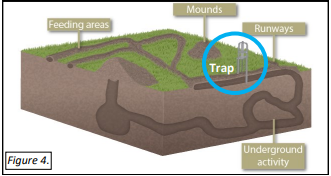
Identify the main and most actively used runways. Deep runway tunnels, along long straight stretches, are generally more effective sites for trapping (Figure 4), while surface tunnels are often temporary. To identify an active pathway, poke holes in observable runways and watch for mole repair activity; moles will quickly repair holes in the main runways. Traps should be set only once the active runways are identified (Figure 5).
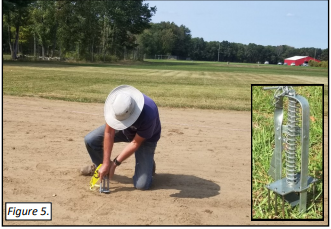
Barriers
Vertical underground barriers can provide temporary relief in small landscape plantings, but in large, open areas they are impractical. They can be easily constructed from galvanized hardware cloth, aluminum sheathing or wire mesh. To protect existing landscape plantings, the barrier should be planted 18-24 inches deep, with an additional 6 inches lip of mesh bent at a 90 degree angle away from the planting, to discourage moles from digging under it.
Chemical Products
Minimum Risk/EPA Exempt 25(b): Products that contain ingredients that meet the approved CT DEEP’s definition of allowable EPA minimum risk 25(b) may be considered for K-8 schools. 25(b) product usage must be included in the school’s IPM plan. The current available 25(b) product list can be found at portal.ct.gov/DEEP/pesticides.
Products intended to control grubs do not necessarily prove effective in the management of mole populations. While grubs are a key food source for moles, they are but one food source. In large turf grass areas, moles move freely regardless of grub presence. On K-8 properties that have adopted pesticide-free protocol, maintaining a dense, healthy turf with proper nutrition and consistent overseeing is paramount. If safe playing field surfaces are challenged by grub populations, then allowed biological agents such as entomopathogenic nematodes (EPN’s) or state approved biological products, such as Grub Gone, should be considered. Where synthetic grub control is allowed (e.g., on high school properties), use of the least toxic product should be considered and must be included in the school’s IPM plan.
Synthetic Baits and Fumigants: On municipal or high school properties where pesticides can be included as part of an IPM plan to manage mole populations, commercial bait and fumigant products may be an option. As with any pesticide product, the target pest should be controlled without harm to other mammals that may directly consume or come in contact with the product.
Talpirid (active ingredient Bromethalin) is the recommended bait to eradicate moles, as it offers less opportunity for secondary poisoning of animals that may consume targeted moles. Talpirid bait resembles the shape of a worm and is placed into active runways and tunnels (Figures 4 and 6).
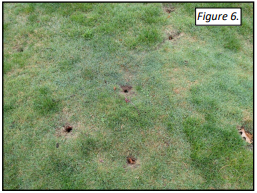
Fumigants offer minimal success in control of moles. Due to extensive tunnel systems (Figure 4), moles might be a long distance away from where a fumigant is released, rendering it ineffective.
Other Considerations
Some suggested mole control measures, including placing irritating materials or vibrating devices in moles’ burrows to antagonize or frighten them, have questionable rates of success. Ultrasonic and electronic devices, which vibrate soil or produce sound also show poor results.
References
Baldwin, R. A., T. P. Salmon, and R.E. Marsh. 2012. Moles Management Guidelines. ipm.ucdavis.edu
Carter, B. and J. Armstrong. 2021. Controlling Damage from Moles and Voles. Alabama A & M. aces.edu
CT Phosphorus Law. cga.ct.gov/2012
Eastern Mole. Wildlife of CT. wildlifeofct.com/eastern%20mole.html
Johnson, K. and J. Pease. Moles: Damage Management. Iowa State University. iastate.edu
Loven, J. 2005. Moles. Purdue University. extension.entm.purdue.edu
Pierce, R. A. 2015. Controlling Nuisance Moles. U. of Missouri. extension.missouri.edu
University of Kentucky. Trapping Moles. Forestry and Natural Resources. uky.edu
Fresenburg, B. 2012. How to Control Moles and Reduce Turfgrass Damage. U. of Missouri. ipm.missouri.edu
The information in this document is for educational purposes only. The recommendations contained are based on the best available knowledge at the time of publication. Any reference to commercial products, trade or brand names is for information only, and no endorsement or approval is intended. UConn Extension does not guarantee or warrant the standard of any product referenced or imply approval of the product to the exclusion of others which also may be available. UConn Extension is committed to providing equal access and full participation for individuals with disabilities within all our programs and activities. Visit s.uconn.edu/accessibility for more resources. UConn is an equal opportunity program provider and employer.
Funds to support the creation of this document were provided by the Crop Protection and Pest Management Extension Implementation Program [grant no. 2017-70006-27201/project accession no. 013777 from the USDA National Institute of Food and Agriculture.
